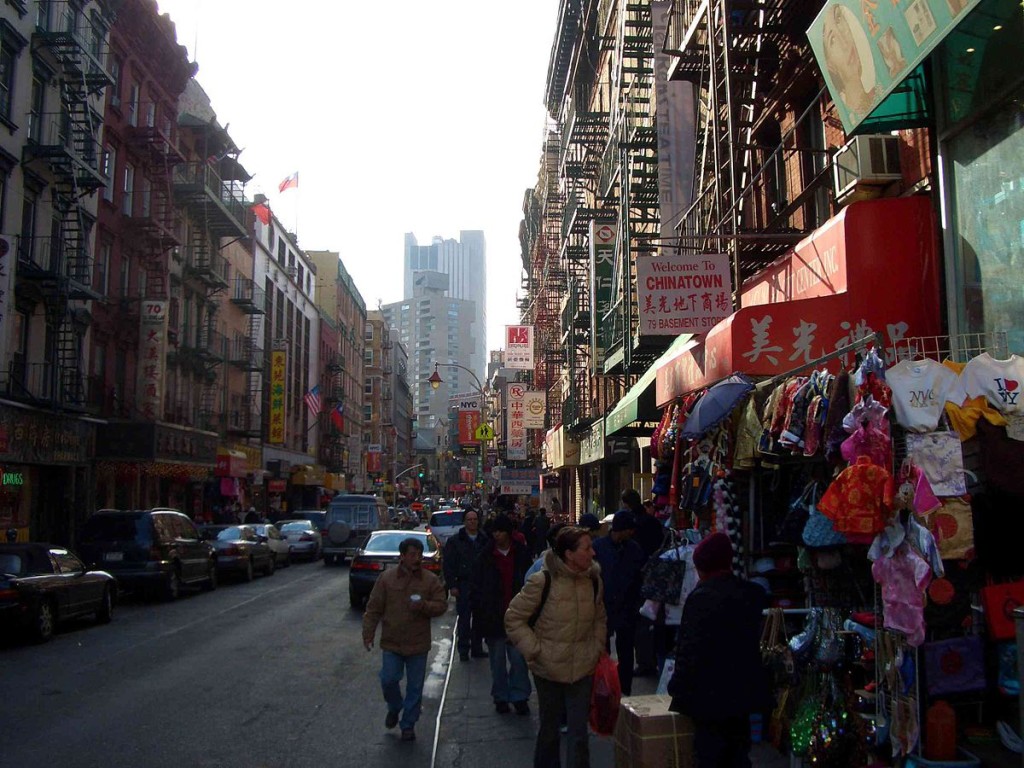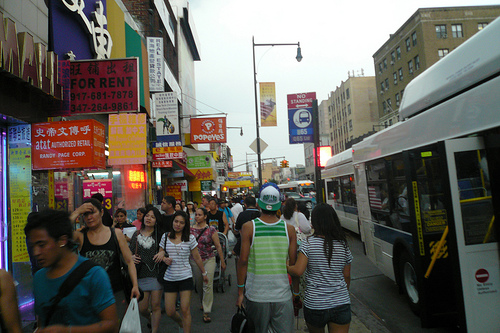
By Demi Guo
The scene has changed gradually over the last 20 years – the two story Duane Reade pharmacy on the corner of Roosevelt was once upon a time an Old Navy, the red bowl on the roof of the Red Bowl restaurant has a new pair of chopsticks, and tourists eat wontons in the White Bear restaurant behind Main Street.
Despite what Wikipedia, Yelp and several blogs say, few, if any, residents call this ethnoburb in Queens “Chinatown,” nor do they call its extension on Northern Boulevard “Koreatown.” To them, Chinatown is the district down Manhattan’s Canal Street while Koreatown is the district by Broadway east of Penn Station. Residents down Eighth Avenue in Sunset Park, Brooklyn and Broadway Street in Elmhurst, Queens tell the same story. Any residents who do call Sunset Park, Elmhurst and Flushing ‘Chinatowns’, said Richard Hourahan, curator and collections manager of the Queens Historical Society, “are just not thinking.”
“‘Chinatown’ as a term is a really big word used very, very generally,” said Peter Kwong, a distinguished professor of urban affairs and planning at Hunter College and a professor of sociology at the Graduate Center of the City University of New York. Traditional Chinatowns, he added, have come a long way from the 1800s racially segregated slums housing unskilled minorities usually unable to speak English. These Chinatowns are now historic landmarks dotting cities from San Francisco to New York City.
In the 1960s, as an assistant professor with a political science PhD from Columbia University, Kwong was “uptown” Chinese. That’s the wealthier and educated Chinese population generally living in the well-to-do upper east side of Manhattan, while “downtown” Chinese were the poorer immigrants in Chinatown living in the lower east side. The terms are now obsolete, he said, as enclaves like Flushing are neither uptown nor downtown, but somewhere in between.
Now light from the big screens that adorn the building across the street shines on the Flushing Library, whose steps serve as a meeting place in the middle of its Main Street. It’s the same for Queens Crossing, a mall that houses the Paris Baguette, a Korean bakery chain now found in Times Square, and Kung Fu Tea, a Taiwanese bubble tea chain found in Chicago’s Chinatown. In contrast Manhattan’s Chinatown – or to Flushing residents, “Tang Ren Jiē,”- lacks these big screens. It manages to keep some of its touristy, historical-slum charm despite signs of gentrification, including a Starbucks with red pillars and curved roofs at 241 Canal Street.

Manhattan Chinatown’s self-identified Chinese population of 28,752 is surpassed by Flushing’s self-identified Chinese population of 486,463, according to the New York City Department of Planning’s 2010 census. While Chinatown’s Asian population is 92.2 percent Chinese, Flushing’s is 67.8 percent. The earliest wave of Flushing’s foreign-born residents were skilled workers who came for the 1964 New York World’s Fair.
Sunset Park in Brooklyn, like Flushing, has retained a steady stream of Chinese mom and pop stores on Eighth Avenue. The Asian population dwindles near Italian and Jewish homes and stores as far as Bay Parkway. This is a trait shared by Flushing and Elmhurst, which overlap into each other through distinctive Latino neighborhoods where Mexicans sell tacos under the bridge and El Salvadorians visit bakeries for pupusas.
“Wikipedia calls every Asian area Chinatown,” concluded Maggie Cai, 20, a lifelong resident of Sunset Park, and those who call any area like Sunset Park, Flushing or Elmhurst Chinatown are usually outsiders, according to John Choe, executive director of the Greater Flushing Chamber of Commerce and director of One Flushing, a nonprofit community economic center.
Flushing stretches from Northern Boulevard to the Long Island Expressway in a web dotted by cultural businesses including Korean, Bengali, Nepalese and Greek overlapping into Bayside. On top of that, said Choe, there has been an influx of ethnic Koreans from Chinese backgrounds, further blurring the lines in the distinctively Chinese enclave, many of whose residents speak with northern Chinese accents including Tianjin and, more recently, southern dialects with new waves of immigrants from the Chinese province Fujian and Chinese city of Wenzhou. A 2013 survey by One Flushing counted 21 languages, including Russian and Tagalog, spoken throughout at least 400 Flushing businesses.
This diversity, said Hourahan, is what sets Flushing apart from Chinatown. As Kwong put it, Flushing is a more concentrated, singularly and distinctly ethnic enclave borne from late 1800s segregation. It is an example of New York’s status as a melting pot instead of just a city of socially segregated ethnoburbs like Chinatown and Little Italy.
However, Kwong finished, “Chinatown” is the shortest, most adequately casual term to describe Chinese enclaves like Flushing. As Choe puts it, the use of the term is done out of “laziness.”
(A version of this story was originally published in Asian American E-Zine)

RE: There is only one Chinatown in NY: Flushing as a whole is obviously not a Chinatown in the same way the entire Lower East Side isn’t a Chinatown. But there is no question that Main St. from Sanford to Northern Blvd IS absolutely a Chinatown.
RE: There’s only one Chinatown in NYC: Not sure if trolling or just didn’t read the article. But will reiterate regardless.
A Chinatown, as defined in this article by its sources, is a now a historical landmark symbolizing a time when social segregation for Chinese people was more sharply defined. Flushing, Sunset Park, Elmhurst…all these places developed within the last 50 years. They don’t have the same historical significance.
And while we’re at it, we should stretch out over all the Main Street blocks. Please don’t tell me the blocks around Queens Crossing are purely Chinese, unless Kim Ga Nae and Caffe Bene have magically become non-Korean.
Not sure why you need to be so oddly specific on something that I’ve already confronted. Main Street does not stop at Sanford, nor do the distinct Chinese businesses. How about the Chinese population past Sanford? You have seen the Fayda and the Jin Shan and all those restaurants and residencies, all reaching past Sanford, right? This chain at least eases once you hit the South Asian businesses before picking back up in Queensboro Hill.
Furthermore, most residents of Flushing, Sunset Park and Elmhurst don’t call Flushing a Chinatown. It’s awfully important to let the people speak for themselves, don’t you think?
RE: There’s only one Chinatown in NYC: Flushing, Main St. is a new Chinatown, there are tourist and local NY-ers are defining it as a new Chinatown. The original Chinatown will always be the original Chinatown, but what’s wrong with having a second Chinatown?
RE: There’s Only one #Chinatown in NYC: Because most of the locals of Flushing won’t define it as one.